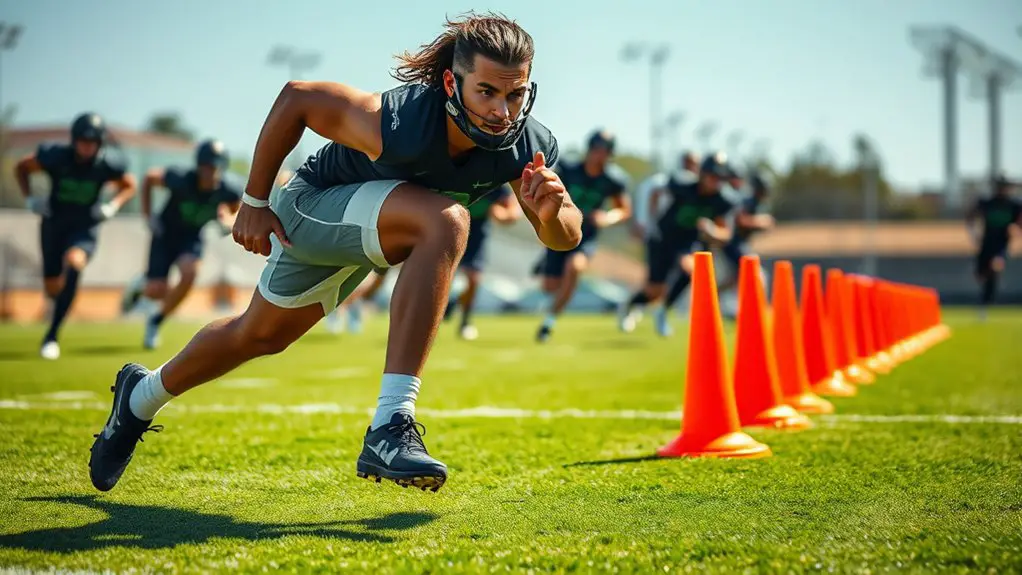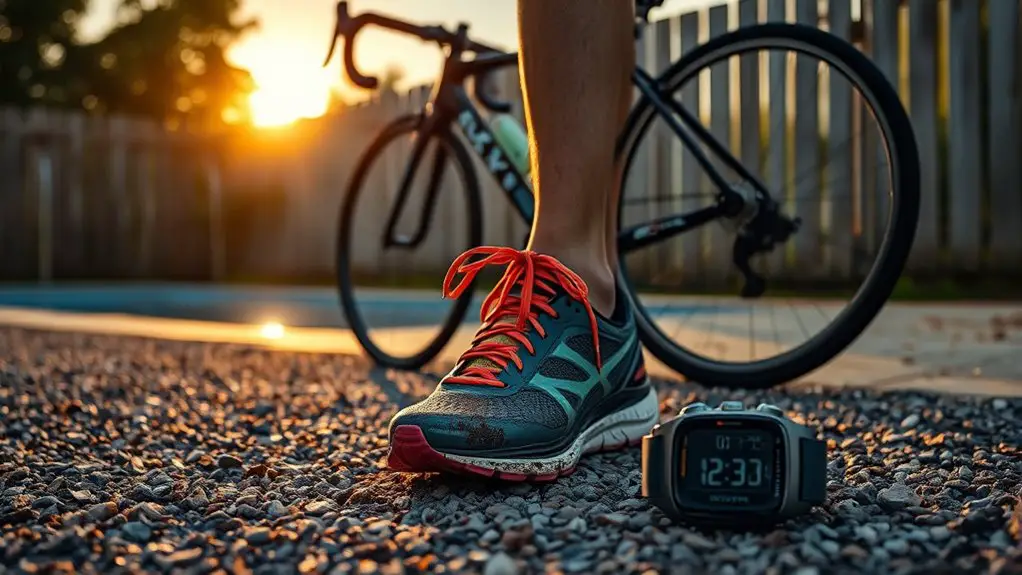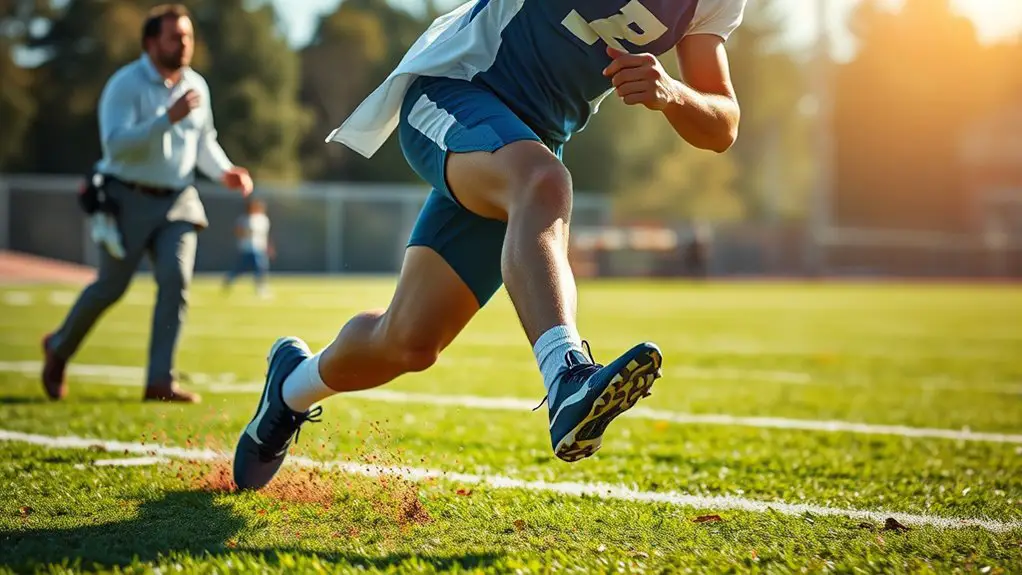To improve your agility for American football, focus on drills like ladder and cone exercises to sharpen your footwork and change of direction. Incorporate plyometrics, such as jump squats and box jumps, to develop explosiveness. Strength training is essential for building the power you need to enhance your speed and stability. Don't forget core strength and flexibility to maintain balance and reduce injury risk. Stay tuned to discover more techniques to elevate your agility on the field!
Understanding Agility in Football
Understanding agility is the cornerstone of success in American football, allowing players to change direction swiftly and evade opponents. It's not just about speed; it's about how well you can maneuver in tight spaces while maintaining control. When you think of agility, picture the freedom in your movements—flowing from one action to another seamlessly. This fluidity lets you break free from defenders and create opportunities on the field.
Understanding your body's mechanics is key. You've got to be aware of your center of gravity and balance, as these elements play a huge role in your agility. Whether you're a running back dodging tackles or a wide receiver making quick cuts, mastering agility gives you an edge. Integrating agility training techniques is essential for enhancing your performance. Embrace the challenge of refining your skills; it's all about releasing your potential. With practice and determination, you'll find that agility opens doors to a more dynamic, successful game.
Essential Agility Drills
To boost your agility on the field, incorporating essential drills is key. Ladder drills can greatly enhance your footwork and coordination, while cone drill techniques sharpen your change of direction. Let's explore how these exercises can elevate your game. Consistency in practice leads to significant improvements in athletic performance, making agility drills an essential part of your training routine.
Ladder Drills Benefits
Ladder drills are a game-changer for enhancing your footwork and overall agility on the football field. These drills sharpen your coordination and quickness, making it easier to navigate through defenders and execute precise movements. When you practice ladder drills, you'll develop muscle memory that translates into improved on-field performance.
Moreover, they're versatile—allowing you to customize your routines to focus on specific skills you want to enhance. You can challenge yourself with various patterns and speeds, keeping your training fresh and engaging. Plus, they require minimal equipment, so you can do them anywhere! Embrace these drills to release your potential, boost your confidence, and enjoy the freedom to move with agility and grace during the game.
Cone Drill Techniques
Mastering cone drill techniques is essential for elevating your agility on the football field. These drills allow you to enhance your quickness, balance, and overall movement. Start with the basic four-cone drill: set up four cones in a square, sprint to each cone, and change direction sharply. This'll help you develop explosive movements.
Next, try the T-drill, arranging three cones in a T-shape. Sprint to the top cone, then shuffle side to the left and right cones, before backpedaling to the start.
Don't forget the figure-eight drill, weaving through two cones. These techniques not only sharpen your footwork but also boost your confidence. Embrace the freedom of movement and watch your agility transform on the field!
Footwork Techniques for Better Agility
Agility on the football field often starts with effective footwork techniques that can elevate your performance. Mastering the basics, like the quick step, can give you that edge. Focus on keeping your knees high and your feet light. When you practice lateral movements, think about staying low and quick, allowing for sharp cuts and sudden changes in direction.
Try incorporating drills that emphasize foot speed, like ladder drills or cone sprints. These exercises can sharpen your reaction times and improve your ability to navigate tight spaces. Don't forget about the importance of balance; it's essential for maintaining control while moving swiftly. Proper footwork can significantly reduce the risk of injuries through effective techniques, ensuring you stay in the game longer.
Finally, a strong stance will set you up for success. Your feet should be shoulder-width apart, ready to spring into action. By honing these footwork techniques, you'll find yourself more agile and responsive on the field, ready to make those game-winning plays.
Incorporating Plyometrics Into Your Training
After honing your footwork techniques, adding plyometrics to your training regimen can further enhance your agility and explosiveness on the field. Plyometrics, like jump squats and box jumps, help you develop fast-twitch muscle fibers, which are vital for quick movements and sudden changes in direction. To get started, choose a few key exercises that resonate with you. Focus on explosive movements that mimic game scenarios, like lateral bounds or depth jumps. Aim for short, intense sessions—about 20 to 30 minutes—two to three times a week. It's important to prioritize form over quantity; you want each jump to be powerful and controlled. Incorporating the stretch-shortening cycle into your training will further maximize your explosive potential.
Importance of Strength and Conditioning
Strength and conditioning are essential for enhancing your muscle power, which directly impacts your speed and agility on the field. By focusing on these areas, you can also implement effective injury prevention strategies that keep you in the game longer. Let's explore how a solid strength and conditioning program can transform your performance. Incorporating exercises like squats and deadlifts can significantly boost your overall power and stability, further enhancing your agility.
Enhancing Muscle Power
While you may think agility is solely about quick footwork, enhancing muscle power through a solid strength and conditioning program is equally essential for football players. When you build muscle power, you're not just increasing your strength; you're creating a foundation that allows for quicker, more explosive movements on the field. Think of exercises like squats, deadlifts, and plyometrics. They'll boost your overall power, helping you break tackles and outrun opponents. Incorporating these workouts into your routine will elevate your game, giving you the freedom to move confidently in any situation. Remember, it's not just about speed; it's about how effectively you can harness that speed with powerful muscle engagement. Embrace the grind, and release your full potential!
Boosting Speed and Agility
To maximize your performance on the field, it's crucial to understand that boosting speed and agility goes hand in hand with a solid strength and conditioning program. By focusing on strength, you're not just building muscle; you're enhancing your ability to move quickly and change direction with ease.
Here's a quick reference to key exercises that can elevate your game:
| Exercise | Benefit |
|---|---|
| Squats | Builds leg strength |
| Lunges | Improves balance and power |
| Sprints | Enhances speed |
| Plyometrics | Increases explosiveness |
| Agility drills | Sharpens quickness |
Incorporating these into your routine will set you free to perform at your best, making those game-winning plays possible.
Injury Prevention Strategies
Injury prevention is often overlooked, yet it plays a crucial role in your overall performance and longevity on the field. Prioritizing strength and conditioning is essential; it builds the muscle stability and endurance you need to withstand the physical demands of football. By focusing on core strength, you'll improve balance and reduce the risk of falls or awkward movements that lead to injuries. Additionally, incorporating flexibility training helps maintain your range of motion, making you less susceptible to strains. Remember, a well-rounded conditioning program not only enhances your agility but keeps you in the game longer. Embrace these strategies, and you'll enjoy the freedom to play at your best while minimizing the risk of injury.
Tracking Progress and Setting Goals
As you work on improving your agility for American football, tracking your progress and setting specific goals becomes essential. Start by establishing clear, measurable objectives, like increasing your cone drill speed or completing more shuttle runs. Write these down and keep them visible to remind yourself of what you're aiming for.
Use a training log or app to record your daily workouts, noting improvements and any setbacks. This'll help you identify patterns, monitor your growth, and adjust your training as needed. Celebrate small victories—those incremental improvements keep you motivated. Remember that intrinsic motivation plays a vital role in sustaining your commitment to these goals.
Consider weekly or monthly check-ins to reassess your goals. If you're hitting them consistently, challenge yourself with more ambitious targets. Remember, agility training isn't just about physical skills; it's about mental resilience too. Embrace the journey, and don't shy away from the freedom that comes with mastering your agility on the field.
Frequently Asked Questions
How Does Diet Affect Agility Performance in Football?
Diet plays an essential role in your agility performance. Proper nutrition fuels your body, enhances energy levels, and improves recovery. When you eat right, you'll feel lighter, quicker, and ready to make those explosive moves.
Can Agility Training Prevent Injuries During Games?
Studies show that 50% of athletes experience injuries due to poor agility. By incorporating agility training, you can enhance your movement skills, reducing injury risk and allowing you to play freely and confidently during games.
What Role Does Mental Focus Play in Agility?
Mental focus is essential for agility; it sharpens your reactions and decision-making. When you're fully present, you'll maneuver better, anticipate movements, and adapt quickly, ultimately enhancing your overall performance and minimizing mistakes during play.
How Often Should I Train Agility Each Week?
You should train agility about two to three times a week. This balance allows you to improve without overtraining, keeping your body fresh and ready while enjoying the freedom to explore different workouts and techniques.
Are There Specific Agility Exercises for Different Positions?
Aren't you curious how different positions require unique agility drills? Quarterbacks benefit from quick footwork, while receivers thrive on sharp cuts. Tailoring exercises to your role lets you maximize your performance and embrace your individual strengths.




